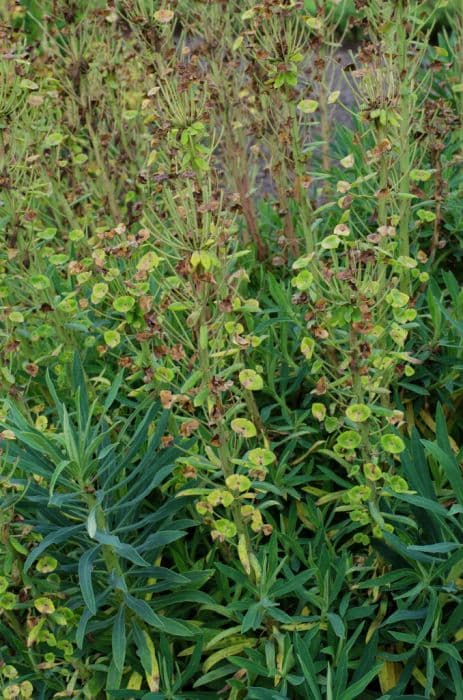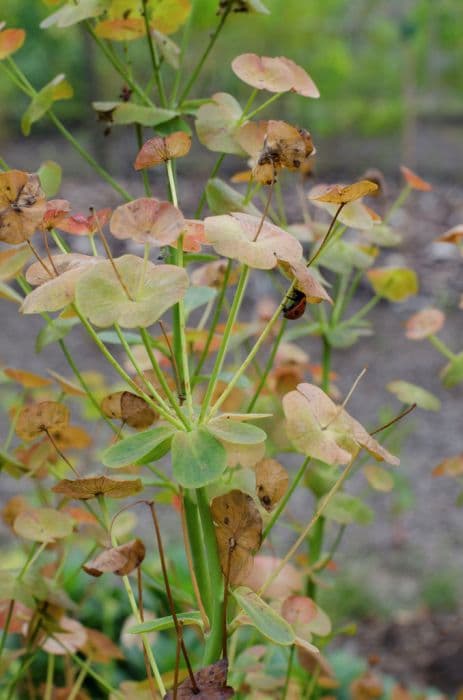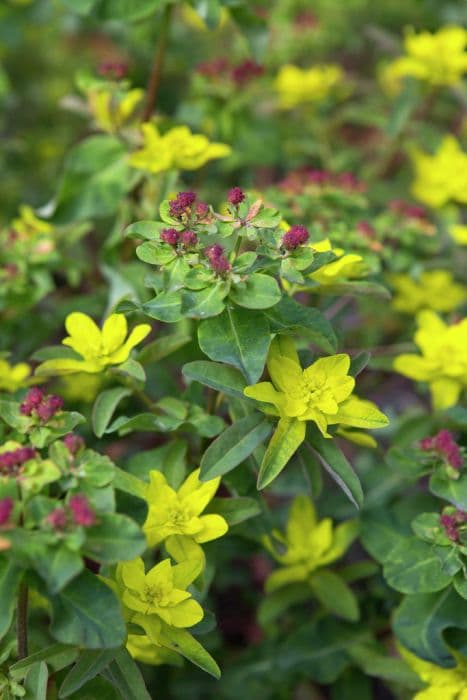Mediterranean Spurge Euphorbia characias subsp. characias 'Blue Hills'

ABOUT
The plant known as 'Blue Hills' Spurge is an eye-catching evergreen shrub that is admired for its striking appearance. It features bushy mounds of blue-green leaves that are narrow and lance-shaped, creating a dense and textured foliage. These leaves often have a unique waxy coating, giving them a blue or glaucous appearance that contributes to the 'Blue Hills' part of its name. During the blooming season, the plant produces upright flower spikes that rise above the foliage. The flowers themselves are actually small and not very noticeable, but they are surrounded by large, showy bracts that are typically bright green or yellow-green, making them appear quite striking against the blue-toned foliage. The bracts and flowers together form a structure that resembles a bottlebrush, providing a bold architectural statement in the garden. These contrasting colors and the attractive form of the 'Blue Hills' Spurge make it a popular choice for adding texture and color to landscapes.
About this plant
 Names
NamesFamily
Euphorbiaceae
Synonyms
Mediterranean Spurge, Blue Hills Spurge, Bluehills Euphorbia
Common names
Euphorbia characias subsp. wulfenii 'Blue Hills'
 Toxicity
ToxicityTo humans
Mediterranean Spurge, the common name of Euphorbia characias subsp. characias 'Blue Hills', contains a toxic white milky sap known as latex. This sap is present in all parts of the plant. If ingested, the sap can cause severe irritation to the mouth and throat, nausea, vomiting, and diarrhea. Contact with skin can lead to irritation, redness, and blistering. If the sap comes into contact with the eyes, there is a risk of temporary blindness and serious eye irritation. Due to these toxic properties, it is crucial to handle Mediterranean Spurge with care and ensure that no part of the plant is ingested.
To pets
Mediterranean Spurge is also toxic to pets due to its sap that contains irritant and toxic compounds. If pets chew or ingest any part of the plant, they might exhibit signs of poisoning such as drooling, vomiting, diarrhea, and in severe cases, difficulty breathing or more systemic effects. The sap can also cause skin irritation and, if it comes into contact with the eyes, serious eye irritation and potential damage. Therefore, it is essential to prevent pets from coming into contact with Mediterranean Spurge and to seek veterinary care if any signs of toxicity develop.
 Characteristics
CharacteristicsLife cycle
Perennials
Foliage type
Evergreen
Color of leaves
Blue-green
Flower color
Yellow-green
Height
3 feet (0.91 meters)
Spread
2 feet (0.61 meters)
Plant type
Shrub
Hardiness zones
8
Native area
Mediterranean
Benefits
 General Benefits
General Benefits- Drought Tolerant: Mediterranean Spurge ('Blue Hills') can survive with minimal water once established, making it ideal for xeriscaping or drought-prone areas.
- Low Maintenance: It requires minimal care, with no need for regular watering, deadheading, or complicated pruning.
- Attracts Pollinators: It provides food for beneficial insects, such as bees and butterflies, which are essential for pollination in the garden.
- Architectural Structure: The upright form and unique texture add visual interest and structure to garden landscapes.
- Evergreen Foliage: It retains its bluish-green leaves throughout the year, contributing to a garden's winter interest.
- Erosion Control: The root system helps to stabilize the soil on slopes or in areas prone to erosion.
- Deer Resistant: Mediterranean Spurge is not particularly palatable to deer, making it a good choice for gardens in areas with deer pressure.
 Medical Properties
Medical PropertiesThis plant is not used for medical purposes.
 Air-purifying Qualities
Air-purifying QualitiesThis plant is not specifically known for air purifying qualities.
 Other Uses
Other Uses- Artistic Dye: Euphorbia 'Blue Hills' can be used to produce a mild dye for fabrics, giving a unique hue to textiles for artistic projects.
- Photography Prop: The striking foliage of Euphorbia 'Blue Hills' can be employed by photographers as a prop to add a touch of natural greenery and texture to their compositions.
- Educational Tool: In schools, Euphorbia 'Blue Hills' can be used as a live example to teach students about plant anatomy, Mediterranean ecosystems, and drought-resistant species.
- Drawing and Painting Inspiration: Artists may draw inspiration from the unique form and coloration of Euphorbia 'Blue Hills' for their painting or drawing projects.
- Culinary Presentation: Although the sap is toxic and the plant should not be consumed, carefully cleaned leaves can be used as a decorative garnish for plating high-end culinary dishes.
- Water Conservation Awareness: Euphorbia 'Blue Hills' can be showcased in water conservation campaigns as an example of a water-efficient plant suitable for xeriscaping and sustainable gardening.
- Crafting Material: The dried stems and seed pods of Euphorbia 'Blue Hills' can be used in crafting for creating wreaths, arrangements, or other decorative items.
- Film and Theatre Set Decoration: The distinctive look of Euphorbia 'Blue Hills' may be used in film and theatre productions to create a realistic Mediterranean or exotic environment on set.
- Privacy Screens: When planted in groups, Euphorbia 'Blue Hills' can function as an informal privacy screen in gardens, thanks to its height and dense foliage.
- Model Landscaping: For architectural models or dioramas, the small-scale representation of Euphorbia 'Blue Hills' can add realism and greenery to the miniature landscapes.
Interesting Facts
 Feng Shui
Feng ShuiMediterranean Spurge is not used in Feng Shui practice.
 Zodiac Sign Compitability
Zodiac Sign CompitabilityMediterranean Spurge is not used in astrology practice.
 Plant Symbolism
Plant Symbolism- Resilience: Euphorbia characias 'Blue Hills' is known for its hardy nature and ability to thrive in less-than-ideal conditions, representing the ability to endure and prosper despite challenges.
- Protection: In folklore, some euphorbias are believed to ward off evil spirits, and their toxic sap symbolizes a natural defense mechanism, suggesting protection from harm.
- Persistence: The perennial nature of this plant, returning year after year, embodies persistence and the idea of overcoming obstacles through steadfastness.
 Water
WaterMediterranean Spurge 'Blue Hills' prefers being watered when the top inch of soil feels dry to the touch. Water thoroughly, allowing the water to seep deeply into the soil, which encourages healthier root growth. Depending on the climate and the season, it might be necessary to water once every 7-10 days. During the hotter, dryer months, you may need to water more frequently, while in cooler or rainy periods, watering can be less frequent. Provide approximately one gallon of water per watering to ensure the soil is adequately moistened but be cautious not to overwater as this plant is drought-tolerant and does not like to sit in wet soil.
 Light
LightThe Mediterranean Spurge 'Blue Hills' thrives in full sun to partial shade. It performs best when it receives at least 6 hours of direct sunlight every day. The ideal spot for this plant is in a location where it can bask in the morning sun and be protected from the intense heat of the afternoon if possible, especially in hotter climates.
 Temperature
TemperatureMediterranean Spurge 'Blue Hills' is hardy and can cope with a wide range of temperatures but prefers a warmer climate. It can survive in temperatures as low as 30°F without serious damage, but for optimal growth, keeping the temperature between 50°F and 75°F is ideal. This plant can withstand occasional dips in temperature and can endure up to 100°F for short periods, which makes it suitable for many different climates.
 Pruning
PruningPrune the Mediterranean Spurge 'Blue Hills' to remove any spent flowers or damaged foliage, which will encourage a bushier growth and maintain the plant's appearance. The best time for pruning is right after the plant has finished blooming, usually in late spring or early summer. It is typically not necessary to prune this plant more than once a year unless you are shaping it or controlling its size.
 Cleaning
CleaningAs needed
 Soil
SoilMediterranean Spurge, or Euphorbia characias 'Blue Hills', thrives in a well-draining soil mix with gravel or perlite to enhance drainage. A soil pH of slightly alkaline to neutral (pH 7.0 to 8.0) is ideal. Mixing two parts loam, one part sand, and one part compost will create a suitable environment for this drought-tolerant plant.
 Repotting
RepottingMediterranean Spurge should be repotted every two to three years to refresh the soil and accommodate root growth. Repot in spring or early summer when plant is entering its active growth phase.
 Humidity & Misting
Humidity & MistingMediterranean Spurge prefers a dry environment and tolerates low humidity well, making it suitable for arid and semi-arid climates. High humidity may lead to issues with rot, so ensure good air circulation if grown in more humid regions.
 Suitable locations
Suitable locationsIndoor
Place in bright, indirect sun; ensure pot has good drainage.
Outdoor
Full sun, well-draining soil; protect from excessive winter wet.
Hardiness zone
7-10 USDA
 Life cycle
Life cycleEuphorbia characias subsp. characias 'Blue Hills', commonly known as Mediterranean Spurge, begins its lifecycle with seed germination, typically in the spring when soil temperatures rise. Seedlings emerge and establish a strong root system, growing into robust plants with upright stems. As it matures, the plant develops its characteristic blue-green foliage and begins to form dense, spherical clusters of yellow-green flowers at the stem tips, usually in early to mid-spring. After pollination, typically by insects, the flowers give way to seed capsules which dry and burst open to disperse seeds. Throughout the summer, the plant continues to grow and can reach its full size, going dormant in the winter before repeating the cycle the following spring. Mediterranean Spurge is a perennial plant, living several years and undergoing this reproductive cycle annually after reaching maturity.
 Propogation
PropogationPropogation time
Early summer
Euphorbia characias subsp. characias 'Blue Hills', commonly known as Mediterranean Spurge, is often propagated through cuttings, a popular method that allows gardeners to clone parent plants. The optimal time for taking cuttings is late spring to early summer when the plant is actively growing. To propagate, cut a piece of the stem about 3 to 5 inches (approximately 7.6 to 12.7 cm) in length from a healthy parent plant using a clean, sharp knife or pruners. It is crucial to allow the cut end of the stem to dry and callus over for a couple of days before planting to prevent rot. Once callused, dip the cutting in rooting hormone and plant it in a well-draining soil mix. Keep the soil moist but not waterlogged and place the cutting in indirect light until roots have developed, which can take several weeks. Once the cuttings have rooted, they can be transplanted into their permanent location.


![Spurge [Silver Swan]](/_next/image?url=https%3A%2F%2Fplants-admin.emdemapps.com%2Fimages%2Fplants%2F%2Fimages%2F604b573f6c8f6.png&w=640&q=75)






